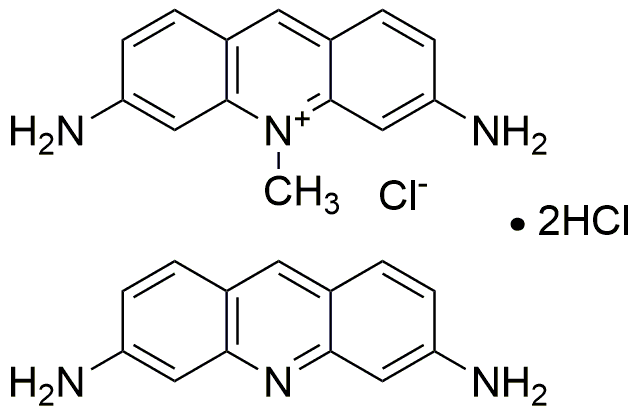Acriflavine hydrochloride is widely utilized in research focused on:
- Antimicrobial Treatments: This compound is effective against a variety of bacteria and fungi, making it valuable in developing topical antiseptics and disinfectants for medical applications.
- Research in Cancer Therapy: Acriflavine has been studied for its potential in cancer treatment due to its ability to intercalate DNA, which may help inhibit tumor growth.
- Veterinary Medicine: It is commonly used in veterinary practices for treating infections in animals, particularly in aquaculture for fish diseases.
- Cell Staining Techniques: In laboratory settings, acriflavine is employed as a fluorescent dye for staining cells, aiding in microscopy and cellular imaging studies.
- Antiparasitic Applications: The compound has shown efficacy against certain parasites, making it a candidate for developing treatments in both human and veterinary medicine.
General Information
Properties
Safety and Regulations
Applications
Acriflavine hydrochloride is widely utilized in research focused on:
- Antimicrobial Treatments: This compound is effective against a variety of bacteria and fungi, making it valuable in developing topical antiseptics and disinfectants for medical applications.
- Research in Cancer Therapy: Acriflavine has been studied for its potential in cancer treatment due to its ability to intercalate DNA, which may help inhibit tumor growth.
- Veterinary Medicine: It is commonly used in veterinary practices for treating infections in animals, particularly in aquaculture for fish diseases.
- Cell Staining Techniques: In laboratory settings, acriflavine is employed as a fluorescent dye for staining cells, aiding in microscopy and cellular imaging studies.
- Antiparasitic Applications: The compound has shown efficacy against certain parasites, making it a candidate for developing treatments in both human and veterinary medicine.
Documents
Safety Data Sheets (SDS)
The SDS provides comprehensive safety information on handling, storage, and disposal of the product.
Product Specification (PS)
The PS provides a comprehensive breakdown of the product’s properties, including chemical composition, physical state, purity, and storage requirements. It also details acceptable quality ranges and the product's intended applications.
Certificates of Analysis (COA)
Search for Certificates of Analysis (COA) by entering the products Lot Number. Lot and Batch Numbers can be found on a product’s label following the words ‘Lot’ or ‘Batch’.
*Catalog Number
*Lot Number
Certificates Of Origin (COO)
This COO confirms the country where the product was manufactured, and also details the materials and components used in it and whether it is derived from natural, synthetic, or other specific sources. This certificate may be required for customs, trade, and regulatory compliance.
*Catalog Number
*Lot Number
Safety Data Sheets (SDS)
The SDS provides comprehensive safety information on handling, storage, and disposal of the product.
DownloadProduct Specification (PS)
The PS provides a comprehensive breakdown of the product’s properties, including chemical composition, physical state, purity, and storage requirements. It also details acceptable quality ranges and the product's intended applications.
DownloadCertificates of Analysis (COA)
Search for Certificates of Analysis (COA) by entering the products Lot Number. Lot and Batch Numbers can be found on a product’s label following the words ‘Lot’ or ‘Batch’.
*Catalog Number
*Lot Number
Certificates Of Origin (COO)
This COO confirms the country where the product was manufactured, and also details the materials and components used in it and whether it is derived from natural, synthetic, or other specific sources. This certificate may be required for customs, trade, and regulatory compliance.


